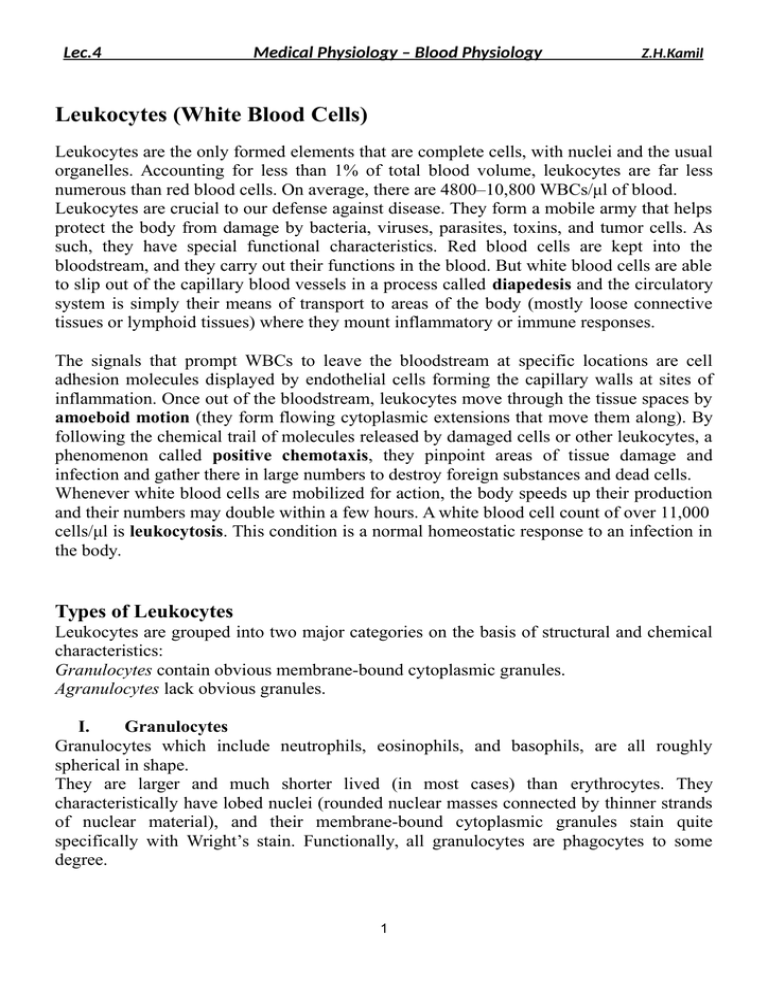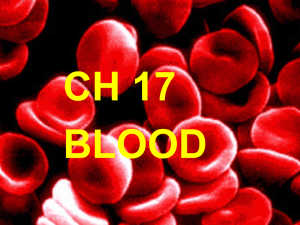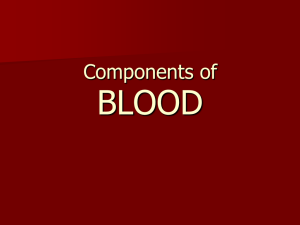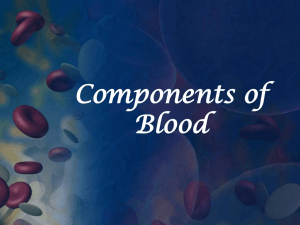Leukocytes (White Blood Cells)
advertisement

Lec.4 Medical Physiology – Blood Physiology Z.H.Kamil Leukocytes (White Blood Cells) Leukocytes are the only formed elements that are complete cells, with nuclei and the usual organelles. Accounting for less than 1% of total blood volume, leukocytes are far less numerous than red blood cells. On average, there are 4800–10,800 WBCs/μl of blood. Leukocytes are crucial to our defense against disease. They form a mobile army that helps protect the body from damage by bacteria, viruses, parasites, toxins, and tumor cells. As such, they have special functional characteristics. Red blood cells are kept into the bloodstream, and they carry out their functions in the blood. But white blood cells are able to slip out of the capillary blood vessels in a process called diapedesis and the circulatory system is simply their means of transport to areas of the body (mostly loose connective tissues or lymphoid tissues) where they mount inflammatory or immune responses. The signals that prompt WBCs to leave the bloodstream at specific locations are cell adhesion molecules displayed by endothelial cells forming the capillary walls at sites of inflammation. Once out of the bloodstream, leukocytes move through the tissue spaces by amoeboid motion (they form flowing cytoplasmic extensions that move them along). By following the chemical trail of molecules released by damaged cells or other leukocytes, a phenomenon called positive chemotaxis, they pinpoint areas of tissue damage and infection and gather there in large numbers to destroy foreign substances and dead cells. Whenever white blood cells are mobilized for action, the body speeds up their production and their numbers may double within a few hours. A white blood cell count of over 11,000 cells/μl is leukocytosis. This condition is a normal homeostatic response to an infection in the body. Types of Leukocytes Leukocytes are grouped into two major categories on the basis of structural and chemical characteristics: Granulocytes contain obvious membrane-bound cytoplasmic granules. Agranulocytes lack obvious granules. I. Granulocytes Granulocytes which include neutrophils, eosinophils, and basophils, are all roughly spherical in shape. They are larger and much shorter lived (in most cases) than erythrocytes. They characteristically have lobed nuclei (rounded nuclear masses connected by thinner strands of nuclear material), and their membrane-bound cytoplasmic granules stain quite specifically with Wright’s stain. Functionally, all granulocytes are phagocytes to some degree. 1 Lec.4 Medical Physiology – Blood Physiology Z.H.Kamil 1. Neutrophils are the most numerous white blood cells, account for 50–70% of the WBC types. Neutrophils are about twice as large as erythrocytes. The neutrophil cytoplasm contains very fine granules (of two varieties) that are difficult to see. Neutrophils get their name because their granules take up both basic (blue) and acidic (red) dyes. Together, the two types of granules give the cytoplasm a lilac color. Some of these granules contain hydrolytic enzymes, and are regarded as lysosomes. Others, especially the smaller granules, contain antimicrobial proteins, called defensins. Neutrophil nuclei consist of three to six lobes. Because of this nuclear variability, they are often called polymorphonuclear leukocytes. Neutrophils are our body’s bacteria killers, and their numbers increase explosively during acute bacterial infections such as meningitis and appendicitis. Neutrophils are chemically attracted to sites of inflammation and are active phagocytes. 2. Eosinophils account for 2–4% of all leukocytes and are approximately the size of neutrophils. Their nucleus usually resembles an old-fashioned telephone receiver— it has two lobes connected by a broad band of nuclear material. Large, coarse granules that stain brick red with acid (eosin) dyes pack the cytoplasm. These granules are lysosome-like and filled with a unique variety of digestive enzymes. However, unlike typical lysosomes, they lack enzymes that specifically digest bacteria. The most important role of eosinophils is to lead the counterattack against parasitic worms, such as flatworms (tapeworms and flukes) and roundworms (pinworms and hookworms) that are too large to be phagocytized. These worms are ingested in food (especially raw fish) or invade the body via the skin and then typically burrow into the intestinal or respiratory mucosae. Eosinophils reside in the loose connective tissues at the same body sites, and when they encounter a parasitic worm, they gather around and release the enzymes from their cytoplasmic granules onto the parasite’s surface, digesting it away. Eosinophils have complex roles in many other diseases including allergies and asthma. While they contribute to the tissue damage that occurs in many immune processes, we are also beginning to recognize them as important modulators of the immune response. 3. Basophils are the rarest white blood cells, accounting for only 0.5–1% of the leukocyte types. Their cytoplasm contains large, coarse, histamine-containing granules that have an affinity for the basic dyes and stain purplish-black. Histamine is an inflammatory chemical that acts as a vasodilator (makes blood vessels dilate) and attracts other white blood cells to the inflamed site; drugs called antihistamines counter this effect. The deep purple nucleus is generally U or S shaped with one or two conspicuous constrictions. 2 Lec.4 Medical Physiology – Blood Physiology Z.H.Kamil Granulated cells similar to basophils, called mast cells, are found in connective tissues. Although mast cell nuclei tend to be more oval than lobed, the cells are similar microscopically, and both cell types bind to a particular antibody (immunoglobulin E) that causes the cells to release histamine. However, they arise from different cell lines. II. Agranulocytes The agranulocytes include lymphocytes and monocytes, WBCs that lack visible cytoplasmic granules. Although similar to each other structurally, they are functionally distinct and unrelated cell types. Their nuclei are typically spherical or kidney shaped. 1. Lymphocytes, accounting for 25% or more of the WBC population, are the second most numerous leukocytes in the blood. When stained, a typical lymphocyte has a large, dark-purple nucleus that occupies most of the cell volume. The nucleus is usually spherical but may be slightly indented, and it is surrounded by a thin rim of pale-blue cytoplasm. Lymphocyte diameter ranges from 5 to 17 μm, but they are often classified according to size as small (5–8 μm), medium (10–12 μm), and large (14–17 μm). 3 Lec.4 Medical Physiology – Blood Physiology Z.H.Kamil Large numbers of lymphocytes exist in the body, but relatively few (mostly the small lymphocytes) are found in the bloodstream. In fact, lymphocytes are so called because most are closely associated with lymphoid tissues (lymph nodes, spleen, etc.), where they play a essential role in immunity. T lymphocytes (T cells) function in the immune response by acting directly against virus-infected cells and tumor cells. B lymphocytes (B cells) give rise to plasma cells, which produce antibodies (immunoglobulins) that are released to the blood. 2. Monocytes account for 3–8% of WBCs. With an average diameter of 18 μm, they are the largest leukocytes. They have abundant pale-blue cytoplasm and a darkly staining purple nucleus, which is distinctively U or kidney shaped. When circulating monocytes leave the bloodstream and enter the tissues, they differentiate into highly mobile macrophages with prodigious appetites. Macrophages are actively phagocytic, and they are crucial in the body’s defense against viruses, certain intracellular bacterial, parasites, and chronic infections such as tuberculosis. 4 Lec.4 Medical Physiology – Blood Physiology Z.H.Kamil Production and Life Span of Leukocytes Like erythropoiesis, leukopoiesis, or the production of white blood cells, is stimulated by chemical messengers. These messengers, which can act either as paracrines or hormones, are glycoproteins that fall into two families of hematopoietic factors, interleukins and colony-stimulating factors, or CSFs. Hematopoietic factors, released by supporting cells of the red bone marrow and mature WBCs, not only prompt the white blood cell precursors to divide and mature, but also enhance the protective potency of mature leukocytes. An early branching of the pathway of leukocytes differentiation divides the lymphoid stem cells, which produce lymphocytes, from the myeloid stem cells, which give rise to all other formed elements. In each granulocyte line, the committed cells, called myeloblasts, accumulate lysosomes, becoming promyelocytes. The distinctive granules of each granulocyte type appear next in the myelocyte stage and then cell division stops. In the subsequent stage, the nuclei arc, producing the band cell stage. Just before granulocytes leave the marrow and enter the circulation, their nuclei constrict, beginning the process of nuclear segmentation. The bone marrow stores mature granulocytes and usually contains about ten times more granulocytes than are found in the blood. The normal ratio of granulocytes to erythrocytes produced is about 3:1, which reflects granulocytes’ much shorter life span (0.25 to 9.0 days). Most die combating invading microorganisms. Despite their similar appearance, the two types of agranulocytes have very different lineages. Monocytes are derived from myeloid stem cells, and share a common precursor with neutrophils that is not shared with the other granulocytes. Cells following the monocyte line pass through the monoblast and promonocyte stages before leaving the bone marrow and becoming monocytes. T and B lymphocytes are derived from T and B lymphocyte precursors, which arise from the lymphoid stem cell. The T lymphocyte precursors leave the bone marrow and travel to the thymus, where their further differentiation occurs. B lymphocyte precursors remain and mature in the bone marrow. Monocytes may live for several months, whereas the life span of lymphocytes varies from a few hours to decades. Leukocyte Disorders Overproduction of abnormal leukocytes occurs in leukemia and infectious mononucleosis. At the opposite pole, leukopenia is an abnormally low white blood cell count, commonly induced by drugs, particularly glucocorticoids and anticancer agents. 5 Lec.4 Medical Physiology – Blood Physiology 6 Z.H.Kamil








